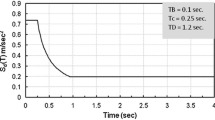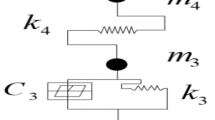Abstract
At present, there is not much research on mid-story isolated structures in mountainous areas. In this study, a model of a mid-story isolated structure considering soil-structure interaction (SSI) in mountainous areas is established along with a model that does not consider SSI. Eight long-period earthquake waves and two ordinary earthquake waves are selected as inputs for the dynamic time history analysis of the structure. The results show that the seismic response of a mid-story isolated structure considering SSI in mountainous areas can be amplified when compared with a structure that does not consider SSI. The structure response under long-period earthquakes is larger than that of ordinary earthquakes. The structure response under far-field harmonic-like earthquakes is larger than that of near-fault pulse-type earthquakes. The structure response under near-fault pulse-type earthquakes is larger than that of far-field non-harmonic earthquakes. When subjected to long-period earthquakes, the displacement of the isolated bearings exceeded the limit value, which led to instability and overturning of the structure. The structure with dampers in the isolated story could adequately control the nonlinear response of the structure, effectively reduce the displacement of the isolated bearings, and provide a convenient, efficient and economic method not only for new construction but also to retrofit existing structures.
Similar content being viewed by others
References
Al-Ghazali AS and Shariatmadar H (2021), “Hybrid Active Control of Adjacent Buildings Interconnected by Viscous Dampers Utilizing Type-2 Fuzzy Controller Considering Soil Structure Interaction,” Structures, 33(2): 292–306.
Cheng Y, Dong YR, Qin L and Li YX (2021), “Seismic Energy Response of SDOF Systems Subjected to Long-Period Ground Motion Records,” Advances in Civil Engineering, 2: 1–20.
GB 50011-2010 (2010), Code for Seismic Design of Buildings, China Architecture and Building Press, Beijing, China. (in Chinese)
Gharad AM and Sonparote RS (2021), “Evaluation of Vertical Impact Factor Coefficients for Continuous and Integral Railway Bridges Under High-speed Moving Loads,” Earthquake Engineering and Engineering Vibration, 20(2): 495–504.
Givoli D (2004), “High-Order Local Non-Reflecting Boundary Conditions: A Review,” Wave Motion, 39(4): 319–326.
Haider A, Song E and Li P (2019), “Numerical Simulation and Absorbing Boundary Conditions for Wave Propagation in a Semi-Infinite Media with a Linear Isotropic Hardening Plastic Model,” Soil Dynamics and Earthquake Engineering, 125: 105627.
Kim GC, Kim SG and Kang JW (2016), “Application of Mid-Story Isolation System for Seismic Response Reducing of Dome Structure,” Journal of the Korean Association for Spatial Structures, 16(4): 37–44.
Kouroussis G, Verlinden O and Conti C (2011), “Finite Dynamic Model for Infinite Media: Corrected Solution of Viscous Boundary Efficiency,” Journal of Engineering Mechanics, 137(7): 509–511.
Li AQ, Xuan P, Xu YM, et al. (2015), “Status and Development Prospects of Story Isolation for Buildings,” Industrial Construction, 45(11): 1–8. (in Chinese)
Li DL, Hua SG and Zhu B (2019), “Analysis of Multiple and Rare Earthquake Responses of a High Rise Isolated Structure,” Earthquake Resistant Engineering and Retrofitting, 41(2): 32–42. (in Chinese)
Li XH, Wang WK, Wu D, et al. (2014), “The Bounded Method and Characteristics Analysis for Long-Period Ground Motions,” Journal of Vibration Engineering, 27(5): 685–692. (in Chinese)
Lin G, Li ZY and Li JB (2021), “Dynamic Soil-Structure Interaction Under Complex Soil Environment,” Chinese Journal of Geotechnical Engineering, 43(9): 1573–1580. (in Chinese)
Liu JB, Gu Y and Du YX (2006), “Consistent Viscous-Spring Artificial Boundaries and Viscous-Spring Boundary Elements,” Chinese Journal of Geotechnical Engineering, 28(9): 1070–1075. (in Chinese)
Liu JB and Lv YD (1998), “A Direct Method for Analysis of Dynamic Soil-Structural Interaction,” China Civil Engineering Journal, 31(3): 55–64. (in Chinese)
Liu JB, Wang ZY, Du XL, et al. (2005), “Three-Dimensional Visco-Elastic Artificial Boundaries in Time Domain for Wave Motion Problems,” Engineering Mechanics, 22(6): 46–51. (in Chinese)
Liu JH and Yang JM (2016), “Discussion on the Related Problems of Mountain Building Design,” Building Structure, 46(S2): 116–121. (in Chinese)
Liu ZJ, Ruan XX and Liu ZX (2022), “Performance-Based Global Reliability Assessment of a High-Rise Frame-Core Tube Structure Subjected to Multi-Dimensional Stochastic Earthquakes,” Earthquake Engineering and Engineering Vibration, 21(2): 395–415.
Mazza F (2016), “Nonlinear Seismic Analysis of Unsymmetric-Plan Structures Retrofitted by Hysteretic Damped Braces,” Bulletin of Earthquake Engineering, 14(4): 1311–1331.
Rajkumar K, Ayothiraman R and Matsagar VA (2021), “Effects of Soil-Structure Interaction on Torsionally Coupled Base Isolated Machine Foundation Under Earthquake Load,” Shock and Vibration, 2021: 1–18.
Rama Rao GV, Sunil JC and Vijaya R (2021), “Soil-Structure Interaction Effects on Seismic Response of Open Ground Story Buildings,” Sādhanā, 46(2): 1–17.
Shohei Y, Hideo F, Yoichi M, et al. (2018), “Real-Time Hybrid Simulation of Semi-Active Control Using Shaking Table: Proposal and Verification of a Testing Method for Mid-Story Isolated Buildings,” Japan Architectural Review, 1(2): 221–234.
Stefano S and Terenzi G (2012), “Dissipative Bracing-Based Seismic Retrofit of R/C School Buildings,” The Open Construction and Building Technology Journal, 6(1): 334–345.
Tsipianitis A and Tsompanakis Y (2022), “Improving the Seismic Performance of Base-Isolated Liquid Storage Tanks with Supplemental Linear Viscous Dampers,” Earthquake Engineering and Engineering Vibration, 21(1): 269–282.
Wang XW, Zhang XA, Shahzad MM, et al. (2021), “Research on Dynamic Response Characteristics and Control Effect of Mega-Sub Controlled Structural System Under Long Period Ground Motions,” Structures, 29: 225–234.
Wolf JP (1986), “A Comparison of Time-Domain Transmitting Boundaries,” Earthquake Engineering and Structural Dynamics, 14(4): 655–673.
Wu YT, Lin XB, Li YM, et al. (2014), “Seismic Collapse-Resistant Capacity of Moment Frames Supported by Stepped Foundation in Mountainous City,” Journal of Building Structures, 35(10): 8–89. (in Chinese)
Wu YX, Yan GY, Shi WL, et al. (2017), “Experimental Study on the Seismic Reduction Performance of High-Rise Isolated Structure Under Long-Period Ground Motions,” Journal of Vibration Engineering, 30(5): 806–816. (in Chinese)
Xu G, Li AQ and Chen SF (2017), “Seismic Vulnerability Analysis of Moment Frames Supported by Stepped Foundation,” Journal of Disaster Prevention and Mitigation Engineering, 37(3): 341–347. (in Chinese)
Xu LY, Wu YX and Tian H (2022), “Shaking Table Test of Eccentric Base-Isolated Structure on Soft Soil Foundation Under Long-Period Ground Motion,” Journal of Building Structures, 43(8): 1–15. (in Chinese)
Yan GY, Fang YW and Wu YX (2018), “Mitigation of Nonlinear Responses of Mid-Story Isolation Structures Subjected to Far-Field Long-Period Ground Motions,” Journal of Vibration and Shock, 37(4): 208–218. (in Chinese)
Yan GY, Xiao XF, Pan QF, et al. (2019), “Seismic Absorption Performance of Base Isolated High-Rise Structures Using Friction Pendulums Subjected to Far-Field Long-Period Ground Motions,” Earthquake Engineering and Engineering Dynamics, 39(2): 99–110. (in Chinese)
Zeng JX, Pan QF, Fang YW, et al. (2019), “Impact of Soil Structure Interaction on Seismic-Reduction Performance of Interstory Isolation Structures Under Long-Period Ground Motions,” Industrial Construction, 48(11): 81–86. (in Chinese)
Zhang LQ and Yu JJ (2019), “Definition and Classification of Near and Far Field Long-Period Ground Motions,” Journal of Natural Disasters, 28(2): 29–36. (in Chinese)
Acknowledgment
The authors gratefully acknowledge the financial support from the National Natural Science Fund of China (Nos. 52168072 and 51808467), and the High-level Talents Support Plan of Yunnan Province of China (2020).
Author information
Authors and Affiliations
Corresponding author
Additional information
Supported by: National Natural Science Fund of China under Nos. 52168072 and 51808467, and High-level Talents Support Plan of Yunnan Province of China (2020)
Rights and permissions
About this article
Cite this article
Wan, F., Qin, S., Liu, D. et al. Seismic response of a mid-story isolated structure considering SSI in mountainous areas under long-period earthquakes. Earthq. Eng. Eng. Vib. 23, 151–161 (2024). https://doi.org/10.1007/s11803-024-2231-2
Received:
Accepted:
Published:
Issue Date:
DOI: https://doi.org/10.1007/s11803-024-2231-2




